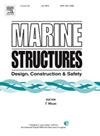Structural integration of glass in yacht superstructures through adhesive bonding – A numerical analysis
IF 5.1
2区 工程技术
Q1 ENGINEERING, CIVIL
引用次数: 0
Abstract
Large luxury yachts often include expansive windows in their designs. The current method of bonding the glass window panes to the supporting structure using a flexible adhesive often necessitates reinforcement in the metallic structure as window size increases. This paper explores an alternative solution where glass is structurally integrated into the yacht. The challenges of integrating glass using structural adhesive bonding is investigated using finite element analysis, focusing on yacht loads and structural deformation. A novel yacht concept with an expansive glazing structure is utilized for this investigation. Following a global load analysis, it is concluded that the glazing structure plays a near negligible role in global strength. Subsequently, a parametric study of the glazing structure is performed under local yacht loads, considering different adhesive bond stiffnesses and glass panel thicknesses. The adhesive bonds are modelled using a contact function with cohesive behaviour. An adhesive Young’s modulus ranging from 500 MPa to 2000 MPa resulted in acceptable stresses and deflections of the glazing structure. A submodel of a region of the glazing structure is created for a more realistic representation of the adhesive material. The geometry of the adhesive significantly affects the magnitude and distribution of stresses within the adhesive material, which the contact function underestimates. Stresses in the adhesive are compared to the strengths of an epoxy adhesive with similar elasticity, but stresses are close to the epoxy’s limits. It was also found that the curvature of the glazing structure plays a role in the deformations experienced by the adhesive bonds.
游艇上部结构玻璃粘接集成的数值分析
大型豪华游艇通常在设计上有宽大的窗户。目前使用柔性粘合剂将玻璃窗板粘接到支撑结构上的方法通常需要随着窗户尺寸的增加而在金属结构中进行加固。本文探索了另一种解决方案,将玻璃结构集成到游艇中。利用有限元分析研究了使用结构粘合剂粘合集成玻璃的挑战,重点是游艇载荷和结构变形。一个新颖的游艇概念与膨胀的玻璃结构被用于这项调查。根据整体荷载分析,得出结论,玻璃结构对整体强度的影响几乎可以忽略不计。随后,考虑到不同的粘合刚度和玻璃板厚度,在局部游艇荷载下对玻璃结构进行了参数化研究。胶结键使用具有内聚行为的接触函数进行建模。粘接杨氏模量在500mpa到2000mpa之间,使玻璃结构具有可接受的应力和挠度。玻璃结构区域的子模型是为了更真实地表示粘合剂材料而创建的。胶粘剂的几何形状显著影响胶粘剂材料内应力的大小和分布,而接触函数低估了这一点。将胶粘剂中的应力与具有相似弹性的环氧胶粘剂的强度进行比较,但应力接近环氧树脂的极限。研究还发现,玻璃结构的曲率对胶粘剂的变形也有影响。
本文章由计算机程序翻译,如有差异,请以英文原文为准。
求助全文
约1分钟内获得全文
求助全文
来源期刊

Marine Structures
工程技术-工程:海洋
CiteScore
8.70
自引率
7.70%
发文量
157
审稿时长
6.4 months
期刊介绍:
This journal aims to provide a medium for presentation and discussion of the latest developments in research, design, fabrication and in-service experience relating to marine structures, i.e., all structures of steel, concrete, light alloy or composite construction having an interface with the sea, including ships, fixed and mobile offshore platforms, submarine and submersibles, pipelines, subsea systems for shallow and deep ocean operations and coastal structures such as piers.
 求助内容:
求助内容: 应助结果提醒方式:
应助结果提醒方式:


